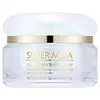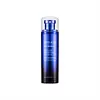What's inside
What's inside
 Key Ingredients
Key Ingredients

 Benefits
Benefits

 Concerns
Concerns

 Ingredients Side-by-side
Ingredients Side-by-side

Snail Secretion Filtrate
Skin ConditioningDimethicone
EmollientGlycerin
HumectantAlcohol
AntimicrobialAdansonia Digitata Seed Extract
Skin ConditioningArbutin
AntioxidantBis-PEG-18 Methyl Ether Dimethyl Silane
EmollientPEG-11 Methyl Ether Dimethicone
EmulsifyingSea Water
HumectantEthylhexyl Isononanoate
EmollientHydroxyethyl Acrylate/Sodium Acryloyldimethyl Taurate Copolymer
Emulsion StabilisingPortulaca Oleracea Extract
Skin ConditioningCarbomer
Emulsion StabilisingTriethanolamine
BufferingPEG-40 Hydrogenated Castor Oil
EmulsifyingPPG-26-Buteth-26
Skin ConditioningCaprylyl Glycol
EmollientParfum
MaskingEthylhexylglycerin
Skin ConditioningTocopheryl Acetate
AntioxidantAdenosine
Skin ConditioningDisodium EDTA
Centella Asiatica Meristem Cell Culture
AntioxidantXanthan Gum
EmulsifyingSnail Secretion Filtrate, Dimethicone, Glycerin, Alcohol, Adansonia Digitata Seed Extract, Arbutin, Bis-PEG-18 Methyl Ether Dimethyl Silane, PEG-11 Methyl Ether Dimethicone, Sea Water, Ethylhexyl Isononanoate, Hydroxyethyl Acrylate/Sodium Acryloyldimethyl Taurate Copolymer, Portulaca Oleracea Extract, Carbomer, Triethanolamine, PEG-40 Hydrogenated Castor Oil, PPG-26-Buteth-26, Caprylyl Glycol, Parfum, Ethylhexylglycerin, Tocopheryl Acetate, Adenosine, Disodium EDTA, Centella Asiatica Meristem Cell Culture, Xanthan Gum
Water
Skin ConditioningGlycerin
HumectantCyclopentasiloxane
EmollientButylene Glycol
HumectantNiacinamide
SmoothingPEG-8
HumectantCyclohexasiloxane
EmollientCamellia Japonica Seed Oil
EmollientHydrogenated Poly(C6-14 Olefin)
EmollientPentylene Glycol
Skin ConditioningDimethicone/Vinyl Dimethicone Crosspolymer
Skin ConditioningPhenoxyethanol
PreservativeAcrylates/C10-30 Alkyl Acrylate Crosspolymer
Emulsion StabilisingAmmonium Acryloyldimethyltaurate/Vp Copolymer
PEG-60 Hydrogenated Castor Oil
EmulsifyingTromethamine
BufferingPropanediol
SolventCaprylyl Glycol
EmollientHydrogenated Lecithin
EmulsifyingPanthenol
Skin ConditioningPyrus Malus Fruit Water
MaskingParfum
MaskingEthylhexylglycerin
Skin ConditioningDisodium EDTA
Anastatica Hierochuntica Extract
AstringentBetula Platyphylla Japonica Juice
Skin ConditioningOpuntia Ficus-Indica Extract
Skin ConditioningPseudoalteromonas Ferment Extract
HumectantMyrothamnus Flabellifolia Callus Culture Extract
AntioxidantOpuntia Ficus-Indica Callus Culture Extract
AntioxidantRhizophora Mangle Callus Culture Extract
AntioxidantSalicornia Herbacea Callus Culture Extract
Emollient1,2-Hexanediol
Skin ConditioningLactobacillus Ferment
Skin ConditioningImperata Cylindrica Root Extract
Skin ConditioningGlyceryl Caprylate
EmollientOpuntia Ficus-Indica Stem Extract
Skin ConditioningAdansonia Digitata Seed Extract
Skin ConditioningAdenium Obesum Leaf Extract
Skin ConditioningPolyglutamic Acid
Skin ConditioningSodium Hyaluronate
HumectantWater, Glycerin, Cyclopentasiloxane, Butylene Glycol, Niacinamide, PEG-8, Cyclohexasiloxane, Camellia Japonica Seed Oil, Hydrogenated Poly(C6-14 Olefin), Pentylene Glycol, Dimethicone/Vinyl Dimethicone Crosspolymer, Phenoxyethanol, Acrylates/C10-30 Alkyl Acrylate Crosspolymer, Ammonium Acryloyldimethyltaurate/Vp Copolymer, PEG-60 Hydrogenated Castor Oil, Tromethamine, Propanediol, Caprylyl Glycol, Hydrogenated Lecithin, Panthenol, Pyrus Malus Fruit Water, Parfum, Ethylhexylglycerin, Disodium EDTA, Anastatica Hierochuntica Extract, Betula Platyphylla Japonica Juice, Opuntia Ficus-Indica Extract, Pseudoalteromonas Ferment Extract, Myrothamnus Flabellifolia Callus Culture Extract, Opuntia Ficus-Indica Callus Culture Extract, Rhizophora Mangle Callus Culture Extract, Salicornia Herbacea Callus Culture Extract, 1,2-Hexanediol, Lactobacillus Ferment, Imperata Cylindrica Root Extract, Glyceryl Caprylate, Opuntia Ficus-Indica Stem Extract, Adansonia Digitata Seed Extract, Adenium Obesum Leaf Extract, Polyglutamic Acid, Sodium Hyaluronate
Ingredients Explained
These ingredients are found in both products.
Ingredients higher up in an ingredient list are typically present in a larger amount.
Baobab seeds are rich in vitamins A, E, and D, giving it nice antioxidant properties.
Caprylyl Glycol is a humectant and emollient, meaning it attracts and preserves moisture.
It is a common ingredient in many products, especially those designed to hydrate skin. The primary benefits are retaining moisture, skin softening, and promoting a healthy skin barrier.
Though Caprylyl Glycol is an alcohol derived from fatty acids, it is not the kind that can dry out skin.
This ingredient is also used as a preservative to extend the life of products. It has slight antimicrobial properties.
Learn more about Caprylyl GlycolDisodium EDTA plays a role in making products more stable by aiding other preservatives.
It is a chelating agent, meaning it neutralizes metal ions that may be found in a product.
Disodium EDTA is a salt of edetic acid and is found to be safe in cosmetic ingredients.
Learn more about Disodium EDTAEthylhexylglycerin (we can't pronounce this either) is commonly used as a preservative and skin softener. It is derived from glyceryl.
You might see Ethylhexylglycerin often paired with other preservatives such as phenoxyethanol. Ethylhexylglycerin has been found to increase the effectiveness of these other preservatives.
Glycerin is already naturally found in your skin. It helps moisturize and protect your skin.
A study from 2016 found glycerin to be more effective as a humectant than AHAs and hyaluronic acid.
As a humectant, it helps the skin stay hydrated by pulling moisture to your skin. The low molecular weight of glycerin allows it to pull moisture into the deeper layers of your skin.
Hydrated skin improves your skin barrier; Your skin barrier helps protect against irritants and bacteria.
Glycerin has also been found to have antimicrobial and antiviral properties. Due to these properties, glycerin is often used in wound and burn treatments.
In cosmetics, glycerin is usually derived from plants such as soybean or palm. However, it can also be sourced from animals, such as tallow or animal fat.
This ingredient is organic, colorless, odorless, and non-toxic.
Glycerin is the name for this ingredient in American English. British English uses Glycerol/Glycerine.
Learn more about GlycerinParfum is a catch-all term for an ingredient or more that is used to give a scent to products.
Also called "fragrance", this ingredient can be a blend of hundreds of chemicals or plant oils. This means every product with "fragrance" or "parfum" in the ingredients list is a different mixture.
For instance, Habanolide is a proprietary trade name for a specific aroma chemical. When used as a fragrance ingredient in cosmetics, most aroma chemicals fall under the broad labeling category of “FRAGRANCE” or “PARFUM” according to EU and US regulations.
The term 'parfum' or 'fragrance' is not regulated in many countries. In many cases, it is up to the brand to define this term.
For instance, many brands choose to label themselves as "fragrance-free" because they are not using synthetic fragrances. However, their products may still contain ingredients such as essential oils that are considered a fragrance by INCI standards.
One example is Calendula flower extract. Calendula is an essential oil that still imparts a scent or 'fragrance'.
Depending on the blend, the ingredients in the mixture can cause allergies and sensitivities on the skin. Some ingredients that are known EU allergens include linalool and citronellol.
Parfum can also be used to mask or cover an unpleasant scent.
The bottom line is: not all fragrances/parfum/ingredients are created equally. If you are worried about fragrances, we recommend taking a closer look at an ingredient. And of course, we always recommend speaking with a professional.
Learn more about Parfum